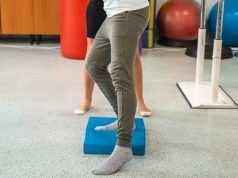Significant improvement in disability; improvement modest and not seen at one-year follow-up
TUESDAY, Oct. 13, 2015 (HealthDay News) — For adults with low back pain (LBP) fitting a decision rule, early physical therapy is associated with modest improvement in disability compared with usual care, but the improvement is not seen at one-year follow-up, according to a study published online Oct. 13 in the Journal of the American Medical Association.
Julie M. Fritz, Ph.D., P.T., from the University of Utah in Salt Lake City, and colleagues examined whether early physical therapy is more effective than usual care for patients with LBP fitting a decision rule. Two hundred twenty participants were recruited between March 2011 and November 2013; all received education. One hundred eight participants underwent four physical therapy sessions in the early physical therapy group, while 112 had usual care, which involved no additional interventions during the first four weeks.
The researchers found that 94.1 percent of participants completed one-year follow-up. After three months, early physical therapy showed improvement in disability relative to usual care (P = 0.02). After four weeks, there was a significant difference between the groups in the Oswestry Disability Index score (P = 0.045), but it was not seen at one-year follow-up (P = 0.19). No improvement was seen in pain intensity at four-week, three-month, or one-year follow-up.
“Among adults with recent-onset LBP, early physical therapy resulted in statistically significant improvement in disability, but the improvement was modest and did not achieve the minimum clinically important difference compared with usual care,” the authors write.
One author disclosed financial ties to Focus on Therapeutic Outcomes.
Copyright © 2015 HealthDay. All rights reserved.








